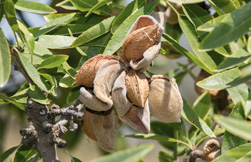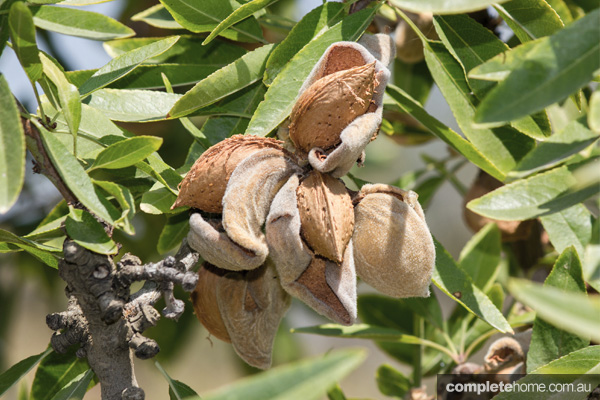A perennial favourite in Mediterranean gardens, almond grows well in most parts of Australia
As much as we like almonds today, it’s unlikely our distant ancestors ate them because the seeds were extremely bitter and poisonous due to a cyanide-like substance they contained. Although bitter almonds are still grown for oil and essence, the table-nut varieties we grow now, called sweet almonds, lack the toxin (a glycoside known as amygdalin) and are safe and delicious to eat.
Almonds are nuts derived from the fruit (technically a drupe, or prune) of a very pretty flowering tree. As a species of Prunus, almonds resemble peaches or nectarines in their growth, habit and flowering. However, unlike those trees, which produce sweet, fleshy fruit, the almond is valued only for its seed. Almonds flower with single pink-white blossoms in late winter or early spring before the tree puts out its leaves. Crops are ready to harvest in summer.
Almonds and bees
In California, where almond trees cover thousands of hectares of farming land, up to 1 million beehives are brought into the groves at flowering time to pollinate the vast numbers of flowers. The movement of such large numbers of hives across the country and the limitations on the bees’ diet from feeding solely on one crop are believed to be factors contributing to the collapse of bee colonies in the US.
Most almonds require cross-pollination for fruit formation but some are self-pollinating. Ideal for the home garden is ‘All-in-One’, which is self-fertile. There are also purely ornamental varieties that don’t produce edible seeds.
Ripe almonds may drop from the tree or can be harvested by hand. Some varieties split open as they ripen to release the edible seed.
Edible and medicinal uses
Almond seeds can be eaten raw, toasted or ground as flour. The seeds are also used to produce almond milk and almond oil. Almonds are extremely nutritious as they are high in vitamin E, essential minerals and good oils.
Growing tips
Almonds need a period of winter chill — around 300 hours below 7°C — to encourage good flowering. They are really frost-tolerant although frost at flowering time can damage flowers and so reduce crops.
They are best suited to areas with cold, wet winters and warm to hot, dry summers, so are ideal for a Mediterranean climate. In Australia, commercial almond production occurs mainly along the Murray River in Victoria and South Australia.
Feed almond trees in spring, as growth resumes in autumn. Once the tree has established a framework of branches, almonds need little pruning other than to keep the centre open and reduce the tree height so it can be netted to protect the crop from birds. To renew growth, remove one established branch each year from around six years of age.
Although the drupe that contains the almond seed isn’t fleshy it can be attacked by fruit fly, so it’s important to maintain control in areas where these pests are active. Use organic baits and lures.
Almonds are also prone to peach leaf curl, a bacterial disease that distorts the leaves. To control this disease, spray almonds (along with peaches, nectarines and apricots) with a homemade organic fungicide before bud burst (the appearance of leaves) in late winter. Bordeaux mixture is a combination of hydrated lime and copper sulphate and can be effective in preventing leaf curl.
Bordeaux mixture
You can easily make this at home using ingredients from your local garden centre or hardware. Simply dissolve 50g of copper sulphate in 2.5 litres of water. In a separate bucket, add the same amount of hydrated lime (calcium hydroxide) to another 2.5L of water. Keep stirring so the mixture doesn’t settle, then pour the bucket of lime into the dissolved copper sulphate mixture.
The mixture is most effective when applied fresh, so use it within a day or so, spraying the mix evenly over the bare branches and swelling buds. The copper sulphate in the mix will temporarily turn the tree blue, so don’t be alarmed. If the mixture looks like it’s settling, give the sprayer a good shake and continue spraying.
Bordeaux mixture is approved for organic use but it’s still important to wear gloves, a mask and protective clothing when mixing and applying this fungicide — and be sure to keep the mixture and ingredients out of reach of children.
If your tree does get infected, you can reduce the incidence of the disease by picking off the affected leaves early and discarding them in the bin (don’t put them in the compost).
Almond label
Common name: AlmondBotanical name: Prunus dulcis
Group: Tree
Requires: Full sun, well-drained soil
Dislikes: High humidity, late frosts
Suitable for: Cool to temperate gardens, orchards
Habit: Deciduous tree 4–10m high
Needs: Water when flowering and fruiting
Propagation: Seed, grafting
Difficulty: Moderate
Originally in Good Organic Gardening, Volume 5, No. 3





